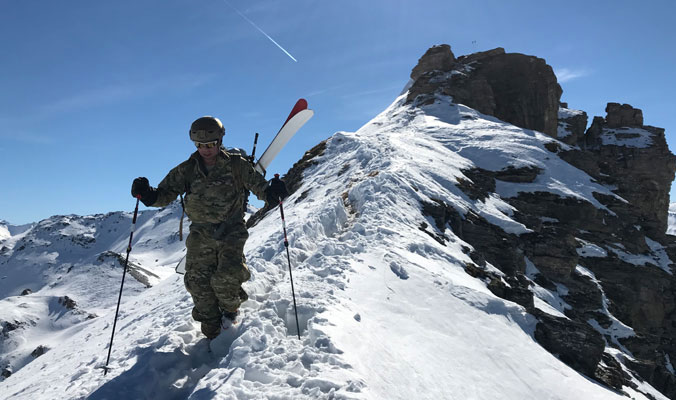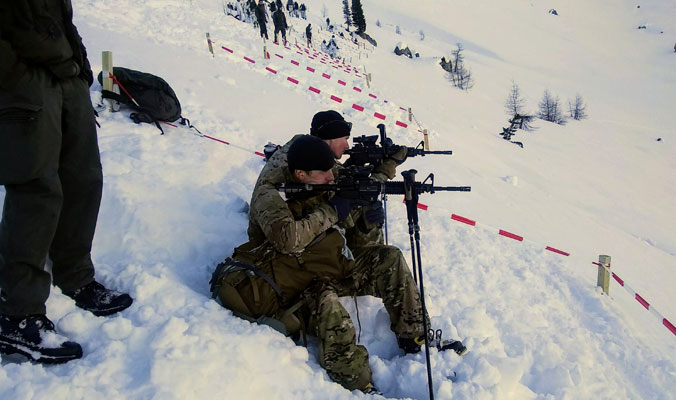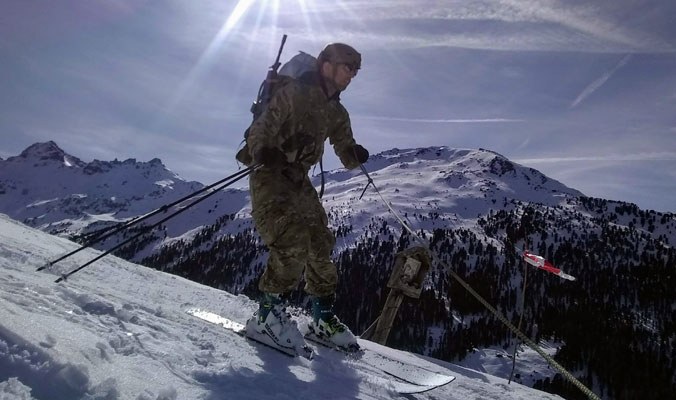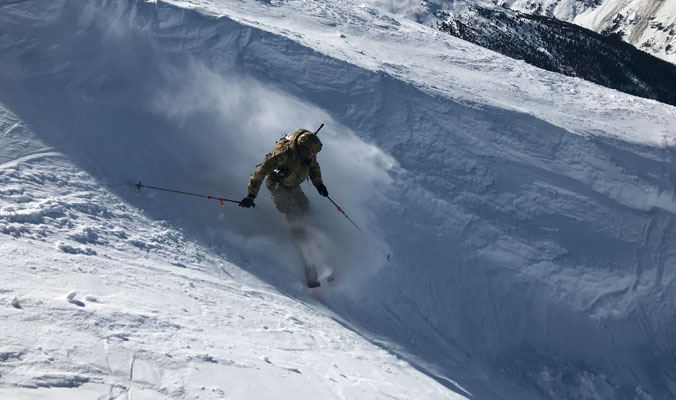
In March 2018, I was a member of a U.S. observer team to an Austrian mountain warfare exercise when I first heard about the Edelweiss Raid. More than a decade ago, the commander of the Austrian Mountain Troops conceived of a skimo race specifically for military ski troops designed to test proficiency in both skiing ability and military skills. In 2009, the Austrians hosted the first Edelweiss Raid high in the Tyrolean Alps, and since its first year, the Raid has grown into a two-day event that covers more than 40 km of distance and 4000 meters in elevation gain. Because of this, the race has become what many recognize as the unofficial world championship for international mountain troops.
It was because of this race that on a day in late February, I stood in anticipation in the Munich, Germany airport as the baggage claim siren screamed and the first pieces of luggage slid onto the conveyor belt. Our team of skimo racers for this year’s event waited, counting nervously as the bags appeared.
We were four days out from our competition and had to drive to Austria that afternoon, a three-hour journey, so we had no time to wait for any lost luggage to show up. “One, two, three,”I counted silently as our duffels started to appear. As we claimed our gear, we breathed a collective sigh of relief and headed to where our bulkier luggage was scheduled to show up. The tension evaporated a bit as a few guys cracked jokes about missing out on skiing on rented equipment. “We’re not through yet,” I thought, knowing that we still had to clear customs. We wheeled our mountain of bags over to the customs area, where a German agent cautiously stood watching us.
“You have something to declare?” he asked, surveying our four carts of equipment. “Umm, yes. But it might ruin your morning,” I quipped. The customs agent wasn’t amused. I leaned over a long, rectangular case, unlocked two padlocks and snapped open the locks. Two black M4 military rifles lay inside. The customs agent raised his eyebrows and surveyed the three other identical cases, all containing weapons. “Is there anything else?” he asked. “We have ammunition, too,“ I replied. He sighed and picked up the phone. “I will need to see some paperwork for this.”

Unlike other skimo races, the emphasis in the Raid is not on lightweight gear and Lycra suits—competitors race in military-issued skis with full combat equipment, rifles, rescue sleds and radios. Packs can weigh between 30 and 50 pounds.
“It is very miserable,” my friend and Military Mountain Guide Matthaus Fruehmann explained before we signed up for the race in July 2018. “But I’ve still done it twice,” he added. “Why doesn’t the U.S. join in the fun?”
This was a chance to showcase the U.S. military mountaineering capability to the world. I knew we had to give it a shot. Unlike how European militaries tend to elevate their mountain troops to the level of Special Operations—the Spanish have even combined their Special Operations and Mountain Warfare Schools into a single organization due to the similarity in rigor—the United States’ mountain troops have always been the black sheep of the military family, tucked into a remote corner of northwestern Vermont, funded on a relatively tiny budget and often forgotten and overlooked by the “Big Army.” However, with years of mountaineering experience, guides’ courses, and student instruction on our resumes, we in the U.S. mountain troops maintain a fierce pride in our specialized skills and proven capability to fight in any terrain, from the streets of Iraq to the mountains of Afghanistan. The Edelweiss Raid sounded like the perfect venue to assess our capabilities alongside our highly trained European allies and show the world that the US was still in the mountain fight.
In the coming months, although it was a pleasant surprise to have our modest funding request for the Raid approved immediately, it also became clear that no one was going to give us weeks of dedicated time to train like the European teams get. If the first U.S. Raid team was going to be successful, we would need the right people, handpicked for their individual dedication and previous experiences.

Recognizing that I would be focused on the administrative side of getting the team to Austria, I asked Mountain Warfare School instructor and accomplished backcountry skier Tim McLaughlin to co-captain the team with me and to focus on the team’s training. A lifelong mountaineer and former Army Ranger, McLaughlin immediately jumped at the offer. Together over the summer of 2018, he and I cobbled together a group of nine military mountain athletes who would train individually but race together in the February 2019 Edelweiss Raid. Also joining us would be Pantelis Geralis, ski instructor and freeskier, Charlie Flood, ski patroller and firefighter, Scott Stone, high school teacher and lacrosse coach, Will Timmons, collegiate Nordic champion, Drew Gelinas, biathlon coach, Rob Niles, Mountain Warfare School instructor, and ski instructor Micah Nevard.
As the summer closed and the first frost began to appear overnight, McLaughlin and I mapped out the team training time that we had available before the race: two days in December, two in January, and then four days in Austria before the race.
“Think we can pull this off?” I asked McLaughlin. He gave one of his characteristic wide smiles. “I guess we have to,” he chuckled. “Your dumb ass has already advertised to the world that we’re racing.”
During our team training events, we coalesced around a specific goal: finish the race with every team member, even if it meant finishing last. In the history of the Edelweiss Raid, no first-year team had ever completed the race with all of its team members. Knowing we had no chance of winning and looking simply to unite our eight racing members around a single identity, “Finish with everyone” became the mantra.
The team departed from various airports of origin on February 22. Four days of rapid acclimatization and team training later, we all stood at the start line of the 2019 Edelweiss Raid. On either side of us, 23 teams of international soldiers in white snow camo stood warming up in the cool morning air. Across the teams, there were 12 different countries represented, all exuding their own personalities. The Germans and Austrians, in competition for the championship title, stood silent and serious, lost in their thoughts and strategies. The Slovenians and Spanish stood to either side of us. As with all first-year teams, we were more relaxed and joked until the crowd quieted as the Austrian race official, a lieutenant colonel dressed in snow camouflage fatigues, spoke into a bullhorn.
“The race will start in one minute,” he called in English to the international crowd. A large race clock began to flash the countdown in red digital numbers. “Skins good, touring locks on, pack tight,” I thought. There was a pop and a green flare shot into the sky. Game on. The mass of white-clad soldiers surged forward to conduct the first task, a multi-burial avalanche beacon search. With the Germans and Austrians in the lead, a long line of mountain troops then began winding up the slope on our first 800-meter climb of the event.

Over the next 48 hours, our team maintained a slow and steady pace and gradually fell into a rhythm: uphill for a couple of hours, summit, rip skins, race downhill as fast as we could go in the heavy spring-like snow with bulky packs, complete a military skills test, repeat. Each individual had a chance to lead the team through the challenges.
Mountain instructor McLaughlin orchestrated the crevasse rescue drill; ski patroller Flood and ski instructors Gelinas and Geralis organized the sled-borne casualty evacuation; platoon leaders Stone and Timmons headed up the range estimation test and sniper Niles finished off the team’s targets during the long-range mountain shooting event.
Through it all as we struggled with steep uphill kickturns and the downhill ski in thick, sloppy snow, we continually reminded each other of the mantra: pick up the slack, maintain the right pace and finish with everyone. As the kilometers clicked away on day two, an exciting tension built within the team—we might just pull this off.
Skiing down the final slope, we rounded a corner and saw the terrain even out for the final event – a “quick march” that would become the decisive factor in our final time standing. I thought to myself, “One more climb, this one as fast as we can move.” We transitioned quickly and began to push up and out of a river valley, then meet the road to the camp, and skin alongside the road for the final two kilometers. Raw and bloodied feet inside ski boots protested and quads groaned under the pace, but there were no complaints. The team had raced together for the previous 38 kilometers, and now it was time to use up the reserves and hold the quick march pace to the end.
Eight members of the first U.S. Army Edelweiss Raid team crossed the finish line on February 28 after 48 hours in the field and over 20 hours of race time. We crossed together as an intact team, placing 13th out of 23 and achieving our goal of becoming the first team to complete the Raid together in their first year. The only challenge that remained for us now? To make it back through Austrian customs with our rifles.










Interesting ! i hope in the future the team finish first, but congrats !!
Outstanding! So glad to hear this group pulled together and finished in a strong manner! (I only wish I had this kind of opportunity when I was in uniform) Well Done!
Yes very interesting. Offbeat, great unusual side of the ski scene, with a lot of unstated connection to the stories so many of us know about the Tenth Mountain Division and more. Thanks.
I was with VTARNG 3/172 Inf (MT)1983-1994 TWO PHASES to be granted the RAMS HEAD. Some may remember me as SP4,or the 45 yr old 2lt to capt. Med platoon leader/State OHN